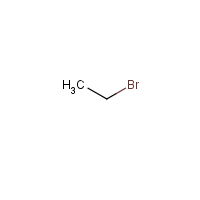Ethyl bromide
Agent Name
Ethyl bromide
Alternative Name
Bromoethane
CAS Number
74-96-4
Formula
C2-H5-Br
Major Category
Solvents

Synonyms
Bromic ether; Bromoethane; Bromure d'ethyle; Ethane, bromo-; Ethyl bromide; Etylu bromek [Polish]; Halon 2001; Hydrobromic ether; Monobromoethane; [ChemIDplus] UN1891
Category
Brominated Solvents
Description
Colorless to yellow liquid with an ether-like odor; Note: A gas above 101 degrees F; [NIOSH]
Sources/Uses
Used in organic synthesis and as a solvent for chemicals and pharmaceuticals; Used in the past as a refrigerant and an anesthetic; [ACGIH]
Comments
Anesthesia and liver toxicity occur in animal inhalation studies; [ACGIH] A skin, eye, and respiratory tract irritant; Inhalation of high concentrations can cause CNS depression; [ICSC]
Biomedical References
Exposure Assessment
Skin Designation (ACGIH)
Yes
TLV (ACGIH)
5 ppm
PEL (OSHA)
200 ppm
IDLH (NIOSH)
2000 ppm
Excerpts from Documentation for IDLHs
Concentrations of 12,000 ppm caused immediate eye irritation in volunteers and 5 minutes at 6,500 ppm resulted in eye irritation, headache, and vertigo [Sayers and Yant 1929]. Workers exposed intermittently to concentrations up to 1,500 ppm complained of no systematic symptoms over a period of several years [Watrous 1947].
Vapor Pressure
467 mm Hg
Odor Threshold Low
3.1 ppm
Lethal Concentration
LC50 (rat) = 26,980 ppm/1H
Explanatory Notes
Odor threshold from CHEMINFO; Flash point = -20 deg C; VP from HSDB;
NFPA
may ignite at ambient temp
Adverse Effects
Neurotoxin
Acute solvent syndrome
Hepatotoxin
Hepatoxic (a) from occupational exposure (secondary effect) or (b) in animal studies or in humans after ingestion
IARC Carcinogen
Not classifiable
ACGIH Carcinogen
Confirmed Animal
Diseases, Processes, and Activities Linked to This Agent
Diseases
Occupational diseases associated with exposure to this agent: